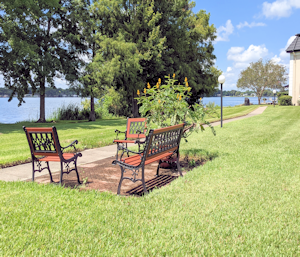

Property Manager
Phone : (407) 628-1086
E-Mail: info@hmi-c1a.com
MAINTENANCE: Unit Owner (Indoor)
While we have divided our maintenance website pages into Owner (Indoor) and Chateaux (Outdoor) responsibilities, it isn't always that clear a division.
Contact the Chateaux Property Manager if you have a question on a specific issue. Do not use anything on this website as support for the Chateaux to pay for repairs or maintenance.
Consult the Chateaux Property Manager before contacting any person or company if you expect the Chateaux du Lac Condominiums to pay for the service or work.
Touch or Click
MAINTENANCE: Unit Owner (Indoor)  to view
Outside maintenance:
to view
Outside maintenance:
Touch or click on a Quick Link below
or SCROLL DOWN this page for
all provided indoor maintenance
covered on this page.
QUICK LINKS:
AC /Heating condensation drain lines
OUTDOOR ELECTRICAL BOX
The outdoor panel breaker
box has a 100 AMP circuit breaker for each of the four units receiving
power through their electrical box to the indoor electric panel in the
hallway of each unit.
If light bulbs are flickering within your condo unit, especially
if you turn on or off a TV, lamps, and other electrical devices this may be
a sign of a loose wire or failing circuit breaker at either the indoor or
outdoor breaker box, or a wall plug/switch inside the unit. Contact a
licensed electrician as soon as possible.
When the outside breaker fails, all electricity to the unit
is cut off. While resetting the breaker on the outdoor panel may return
power to the unit, the resident will want to understand what caused the
breaker to fail.
It is unusual to have an issue with this meter box. In 2017,
Mainline Electrical, a local licensed electrical repair company, completed
the installation of new outdoor master power boxes for almost all our
residential units. These residential outdoor master power boxes contain
each unit's electric power meter and power line feeds to individual units.
Again, it is very unusual to have this breaker fail, so it is
important for the resident to contact a licensed electrician and have
the electric system within the condo inspected.
WATER and
SEWER

Items to note
about water service for each condo unit:
Drain /Sewer
Lines
A unit’s
wastewater clean-out plug is located near the unit’s air conditioner. If a
unit’s wastewater line to the main sewer becomes clogged, a plumber may
remove the cap, and snake the line. The plumber does not need access to the
roof to snake down a vent pipe.
The cleanout line may
have a metal cap or a black
rubber cap.
PHOTO 2

Shown in the photo (2):
A. Outdoor
electric emergency shut-off for air conditioner compressors. Does not shut
off AC equipment indoors.
B.
Many units have their water heater high-pressure relief-valve pipe connected to the outdoor
overflow vent, as shown here. Local and Regional laws require this water
heater pressure release value.
However, if a
toilet line becomes clogged early in the sewer line, the toilet may have to
be unbolted from the floor and the plumber snake or auger into the line
from that point.
The upstairs
and downstairs unit wastewater lines join just before the cleanout
junction, so there is only one cap per set of units on each side of the
hallway.
Individual Unit
Water Shut Off Valve
There is a small blue
dot (see photo below) on the sidewalk that designates a shut off valve is on the condo wall
across from this point the
sidewalk dot.
Each unit has
an outdoor water shutoff valve located on the building wall next to the
patio on the opposite side of the exterior entrance door.

Most residential building water shut-off valves are located near the patios
at the front of each residential building, as shown below. Exceptions
for the routine water line/sewer line building entrance/exit locations
include buildings 5 ,6, 7, and 10. Units in these four buildings have their
water shutoff valves located on the opposite side of their building, near
each unit’s air conditioner at the rear of the building.
Building ten
(10) was constructed in reverse from its neighbor buildings. The water
shutoff is on the courtyard side of the building, even though this is the
rear side of building ten.
Most supply
water lines were installed with one valve a little higher than the second
shutoff line in the same location. The lower valve controls water flow to
the lower unit, with the higher valve adjusting the incoming water for the
second-floor unit. Please note several valves and water line entrance
points are at the same level. Always test your water flow after changing
the valve position to ensure you did not turn on or off your neighbor's
water.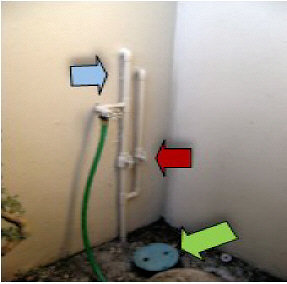
Blue Arrow— Incoming water lines. Taller line is second floor water line.
Red Arrow— Shutoff valves
Green Arrow—
Underground shutoff for both units. Some underground valves are not marked
on top of ground.
As of September
2020, as stated above, some water turn-off valves may be located at ground
level where the water supply lines crawl up the wall to the units. No arrow
in pic for this valve. If you don't see an extra turn off handle, the
handle is below ground.
There are also
eight "regional" water supply line shut off valves that stop incoming water
to all the units within several hallways in that building.
We suggest
testing your unit's individual shut-off valve occasionally to ensure it is
fully operational. Do not use force to turn the valve. If the valve does
not turn easily, submit a maintenance request to the property manager to
have the valve replaced.
Testing the
valve when a Chateaux maintenance man is on property could facilitate
assistance if an issue arises.
We
would suggest the resident turn off the hot water heater if the water
supply line is to be shut off for any long period of time.
In a
waterline-break emergency, if the wall valve fails to stop the water flow,
another water line shut off is in the ground about a foot down, and a foot
away from the building, where the water lines exit the ground.
The underground
water valve controls the water for BOTH upstairs/downstairs units, so
opening or closing this underground valve also affects your neighbor's
unit.
NOTE: SEPTEMBER
2020 - Bryan Plumbing, a local plumbing service, ran new water supply lines
from the water meters to all residential units. Some underground valves may
now be at ground level at the base of the water pipe on the wall leading up
to the units.
Some
underground valves have a cap, or cement block, at ground level to
facilitate the location of the value. Other buildings do not have this
marker. Dig down from where the wall pipes enter the ground and follow the
pipe a foot or two to locate the shut-off for units A and D or Units B and
C.
Be careful digging as some lighting electrical wires, and the unit's
sewer line are in this area as well. The cast iron sewer line is often
right next to the incoming water line and underground shut off valve.

DISHWASHER
Garbage Disposal
Refrigerator water lines
Owner installed water line filters
Bathroom Vent Fans
A quick note that many kitchen dishwashers have food particle traps in the
bottom of the dishwasher.
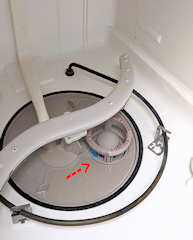
Be sure to occasionally pull, view and empty the filter to ensure the
dishwater properly drains and does not cause a water backup in your
kitchen.
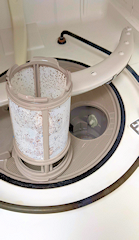
The dishwasher and all water and electric lines leading to and from the dishwasher are the responsibility of the unit owner.
The unit's garbage disposal is also the property and responsibility of the unit owner.
Water line filters, their equipment, and their plumbing connections to water lines are the responsibility of the unit owner.
WATER HEATER
Note that, as
shown in the photo (B) above on this page some water heater drain lines are built into the
wall.
If you see water
coming from the outdoor emergency water heater pressure release pipe (See
"B" in photo below), one of the two connected water heaters might be getting too
hot, or a relief valve is getting old and weak. Perhaps one of the unit's two heater
coils is not turning off at a proper setting.
Pic 2A

Pressure relief
drain lines for water heaters are connected to the other water heater in
the condo unit directly above or directly below your unit.
For a quick
initial water heater check:
Turn off your
unit's electric power for the water heater to see if the problem continues.
You may have to wait a few minutes for the water heat to cool.
Check the top
of your water heater to see / hear if water is being released through the
pressure relief valve. DO NOT disturb the relief valve itself, but you may
feel the pipe at least one foot away after the valve to see if the pipe is
warm, which may mean hot water is running through that valve and pipe.
Even if you do
not see or hear evidence of water being released, while the water heater is
turned off, check the outdoor relief drainpipe again to see if the water
flow has stopped. If not, the issue may not be with your water heater.
If the problem
does continue, you may turn the first water heater back on, and contact
your upstairs or downstairs neighbor.
Have your
neighbor turn the electric power to their water heater off and follow the
same steps as you performed for your water heater check. Then look to see
if the water stops draining from the outdoor drainpipe.
Sometimes,
turning a water heater off for a few minutes, and then turning the unit
back on will solve the problem if the issue was a non-properly working
heater coil (most water heaters have two).
Even if you don't find the issue, it may be wise to call a water heater repair man / plumber to ensure your water heater is working properly. Better to find an issue early than after a blast of water covers the floor.
By the way, did you know that some insurance companies will not cover water damage to a condo unit if the water heater is over ten (10) years old and starts leaking? Check with your insurance agent or your condo insurance policy to see if there are "time-limits" for select appliances in your unit.
Water heaters are the responsibility of the unit owner, not the Association.
MAINTENANCE: AIR CONDITIONER
Air Conditioner maintenance, repairs and costs are the
responsibility of the unit owner.
The A/C condensation drain line serves two units, one above the other.
Unit owners are responsible for occasional drainpipe maintenance
as shown below.
Pic 3

This is Florida. Mildew and algae will grow in your air conditioner drain line year-round. At least every other month during the cooler months, and each month from March through October, we suggest residents pour one cup of hot water (not boiling) down their AC air handler drain line.
Pic 4

Technicians recommend using hot water to un-clog an AC line.
It is suggested you do not add bleach or vinegar into the drain line. Even light
bleach or vinegar fumes rising from the drain line may shorten the life
expectancy of your AC indoor air handler.

Moreover, chlorine bleach can eat away at not only the line but
the glue and cement joining the line to the fittings. Chateaux water and
drain lines are CPVC and PVC, so please first try only hot, but not
boiling, water for clearing clogs and debris from lines.
If you feel you need to use bleach or vinegar, use two tablespoons
of chlorine bleach in a half cup of hot water, or 50/50 mix of white
vinegar and hot water.
Breathing bleach isn’t healthy. If you smell the bleach coming
from the drain line, you should pour another cup of hot water, without
bleach or vinegar, into the pipe. You may have to perform this second step
more than once until you no longer smell bleach or vinegar.
The Association attaches a suction pump to the outside end of each
drain line at least once a year to assist in the removal of mildew and
algae within the line.
If you are having AC drain line issues, submit a maintenance
request to have our maintenance man check your outdoor drain line to ensure
the line is not clogged outdoors with dirt or other foliage.
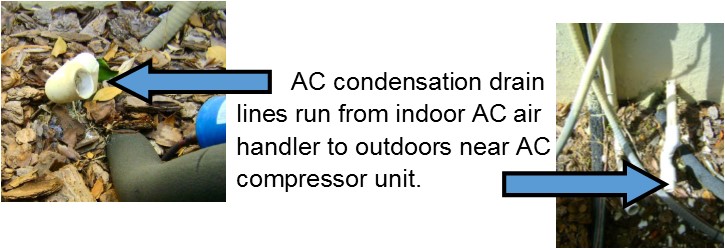
If you prefer not to follow the above steps, or if you are away from
your unit for extended periods, algae tablets may be placed in the air
conditioner drain pan. These tablets often last from three to six months
before having to be replaced.
If your system does not have a drain pan, the tablets or strips
may be dropped directly into the drain line below the indoor unit.
Contact your AC maintenance company for the cost and use of three- or six-month tablets or strips. The size (tonnage) and use of your AC will determine the strength best suited for your unit.

A. Outdoor electric emergency shut-off for air conditioner
compressors. Does not shut off AC equipment indoors.
B. Many units have their water heater high-pressure relief-valve
pipe connected to the outdoor overflow vent, as shown here. Local and
Regional laws require this water heater pressure release value.
SMOKE DETECTOR
Winter Park fire code requires every unit to have
installed a minimum of one fire/smoke detector. At least one
fire/smoke detector must be electricity powered
with battery back-up.
The Winter Park, Florida, Fire Code requires the condo
unit circuit breaker box to have the electricity powered fire/smoke
detector breaker labeled.
Replace the battery in each fire/smoke detector twice a
year or earlier if needed.
The fire/smoke sensor in the detector
uses power twenty-four hours a day sensing for smoke and or quick
and excessive heat changes from flames. The battery should last six
months or longer. When Florida switches to and from Daylight
Savings Time, it is a good reminder to change these batteries.
Some newer smoke detectors have five or ten-year batteries
installed. Be sure and test these and all smoke detector units
monthly.
Fire Extinguisher
Winter Park Fire Code requires every apartment in a
multi-unit building to have at least one fire extinguisher that
meets specific requirements listed below.
Residents might consider more than one smoke detector.
Residents might also wish to have more than one fire extinguisher.
Perhaps one in the kitchen area, and another in the bedroom area,
so an occupant is never caught in a part of the condo unit without
access to a fire extinguisher even if the hallway is filled with
smoke.
If a new fire extinguisher is needed, in May 2019, the City
of Winter Park, Florida, Fire Marshall's office mandated the fire
extinguisher must be no less than five pounds and coded 3-A-40-B:C.
Unit owners may purchase fire extinguishers and smoke
detectors through Chateaux's fire extinguisher certification
company, or from local retail stores, such as Home Depot, Lowes,
Target, and Walmart.
As an estimate of the cost for a new fire extinguisher
meeting Winter Park, Florida, in October 2020, Walmart had fire
extinguishers meeting Winter Park specifications for $38 plus tax.
Costco had a similar fire extinguisher for about $36.
Purchasing a fire extinguisher from a store does not certify
the unit in Winter Park. Each year, around March, the Chateaux
Association hires a company to review and certify all fire
extinguishers on the property. Residents will be notified prior to
each certification process.